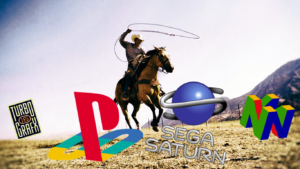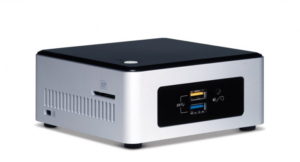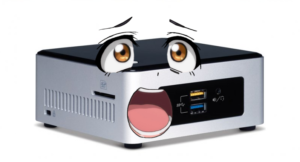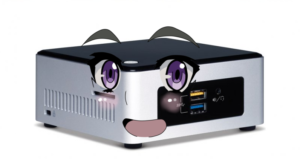Move ’em on, head ’em up
Head ’em up, move ’em on
Move ’em on, head ’em up, emulation
Cut ’em out, ride ’em in
Ride ’em in, cut ’em out
Cut ’em out, ride ’em in, emulation
After not really playing emulated video games for nearly five years, I think it’s time to catch up on what I’ve been missing, as far as new emulators go. But first, a story about one of my computers, because I know that this sort of thing is both interesting and important!
Back in 2015, right around when Windows 10 was released, I bought a little Intel NUC computer. I bought that thing specifically for gaming, and by gaming, I mean emulating. I looked at the specs, and I figured it would be able to handle most of the emulating that I wanted to do on it.
And since this was at the advent of Windows 10, I figured I’d jump into that deep end and get me a new copy of that OS to install on it too. So I got all the parts and installed Windows 10, and started to install some of the latest versions of my favourite emulators.
That’s when I realized that the Intel Iris HD graphics drivers for this thing were absolutely awful back in 2015. Almost nothing worked properly, and I usually narrowed the problems I had down to the Intel Iris drivers. I had problems with any application that went into fullscreen, and I had problems with applications not exiting and crashing instead if they were in fullscreen. I had problems with colours not being right in fullscreen, and some emulators not going into fullscreen at all.
So I reformatted the hard drive and started over again with Windows 7 instead. There was some improvement, but I still couldn’t believe how bad the Iris drivers were even for a mature operating system like Windows 7. I also started to notice that many of the old emulators I’d come to rely on had big problems outside of Windows XP and a 4:3 aspect ratio.
I had to stop using this little NUC for emulating, and repurposed it as my main Internet computer for the next five years. It handled that pretty well until the bloat and sluggishness of modern websites were just too much for it. I actually thought YouTube had killed it when I paused a video for about 10 minutes and came back to see my poor Intel NUC completely shut off and in a prolonged beep of fatal error.
It wouldn’t even boot after that, actually. Time to get a new Internet computer, I guess. And I thought the old little Intel NUC was completely done for until I bought a cheap SSD and tried to boot it with a fresh install of Linux.
And it worked. Well, shit, I might as well try Windows 7 and all those emulators on it, so that’s what I did. And that worked damn near miraculously.
In fact, I couldn’t believe how well this computer handled everything from Atari 2600 right up to Game Cube with such ease and aplomb.
That Intel Iris driver had improved by leaps and bounds too, so credit where credit is due. And of course I had made sure to use the latest versions of my favourite emulators, and some entirely different emulators in some cases. This little NUC is now one of my go-to computers for gaming, when only recently I thought it was done for.
So here’s a console-by-console (and computer) list of the emulators that I’ve switched to or have updated on my little NUC that could.
Atari 2600
I use Stella to emulate this classic console on Windows 7 and above. For Windows XP, I still prefer Z26. There’s actually a new version of Z26 now, which runs on Windows 7 and above, but I find it to be a bit crashy.
Intellivision
I’m still using the great Nostalgia emulator, but unfortunately this emulator doesn’t strictly maintain the correct 4:3 aspect ratio on a widescreen display. I can get the aspect ratio to be a little closer to 4:3 by using a certain resolution in the graphics settings, however. There is also an Intellivision emulator called jzIntv which seems to be still actively developed, but it works via the command line only, and you know how I feel about that.
Commodore 64
I’ve now switched completely to using VICE for all my SID and Epyx needs. I remember I used to use CCS64, and I still have that installed on my Windows XP machines. But VICE is now the most compatible and fully functional Commodore 64 emulator. Also, Compuquiz doesn’t work in CCS64.
ColecoVision
I remember this was one of the first consoles I was able to emulate on my Pentium II running Windows 98. I used AdamEm back then, and I’ve tried many since then, but have usually come back to ColEm. ColEm has gotten pretty damn great over time, but on my Intel NUC, believe it or not I use an emulator called MEKA. That’s actually an emulator that runs old Sega consoles like the SG-1000, Master System, and Game Gear. But it also emulates the ColecoVision! More about it later.
Vectrex
I was unfair to this console when I did my driving game reviews. It actually has lots of great, fun games. The driving games are still unmitigated ass, though. But to emulate it, I use ParaJVE. That emulator requires that Java from Oracle be installed on your computer, but my little Intel NUC is never connected to the Internet, so what’s a little security hole here and there?
Atari 5200
The only way to play this console’s games is through emulation, if you ask me. Even if you can get the shitty, faulty, defective controllers to work, they ruin almost every game because they’re non-centering, lol. So I use Altirra. It plays the Atari 5200 games – which are usually the best console versions of those games you can get – and the Atari 8-bit computer games too. I actually prefer Atari800Win PLus for those games, but it won’t run properly in fullscreen on Windows 7 or 10.
Sega SG-1000 / Sega Master System / Sega Game Gear
If you have a decent gaming PC, then you can use the awesome TwoMBit emulator for these consoles. It does exactly what it should do, though it’s actually too resource-intensive for my little Intel NUC.
So that’s where my old favourite emulator MEKA comes in again! I’ve been using MEKA since I had that old Pentium II running Windows 98. And I still think MEKA has one of the best interfaces out of any emulator I’ve ever used. So I was delighted to see that there is a fairly recent version, which works perfectly on modern operating systems. There is a .bat file which needs to be run to set up screen resolutions, and that’s how you can get the program to maintain a 4:3 aspect ratio on widescreen monitors.
Nintendo Entertainment System
I think there might be more NES emulators than there are games for some consoles. I’ve only ever tried a few. Back in the Windows 98 and early XP days, I rocked FCE Ultra and FCEUX. Those served me well until I found Nestopia, which performs on Windows 7 and my NUC when those old ones, well, don’t.
Atari 7800
I used to use the ProSystem emulator to play these… uh… special games. But that emulator is really, really resource-heavy, and doesn’t work at all in full-screen mode in Windows 7 or Windows 10. There’s also the option to use A7800, which is basically just a specialized fork of MAME. But I’ve very recently discovered BupSystem, which is a very fast and feature-complete emulator for what is still the only way to properly play Ninja Golf.
TurboGrafx 16 / TurboGrafx CD
Yep, I’m still using MagicEngine for these. Yes, I know that means I still have to use Daemon Tools lite to mount disc images to a virtual CD drive. No, I won’t use Mednafen.
Speaking of Mednafen, I saw someone say this actual quote about why people won’t use that shitty command-line only emulator:
“Because 95% of all users are technologically illiterate boomers/zoomers who don’t know how to operate a command line”
Fucking lol. Insult us more, maybe we’ll change our minds.
Anyway. there’s also the option to use Turbo Engine for some of those rare TurboGrafx CD titles that won’t play in MagicEngine.
Sega Genesis / Sega CD / Sega 32X
I’ve been using Kega Fusion to play Genesis, Sega CD, and 32X games for a very long time, that I barely remember when I used to use Gens to play Sanic. But I still keep Gens around because Jeopardy for the Sega CD only works for me in Gens. Priorities, man.
Game Boy / Game Boy Color
I’m still using BGB to emulate these handhelds, and I’ve never even tried any other emulator, to be honest. BGB has been updated very recently too, so feel free to give it a try. I use an old version on my XP machines and on my NUC because they can’t handle the full awesomeness of the latest versions, I guess.
Neo Geo
For this arcade system that was also sold as a home console, I used to use Neo-RAGEx. I’ve recently been using MAME to check out some arcade games, and every Neo Geo game that I used to play in the old emulator can be played more accurately in MAME, so there’s no need to keep it around any more.
Super Nintendo
ZSNES served me well, back from the days of my Windows 98 machine and even up to my under-powered refurbished office computers running Windows XP that served as my gaming PCs in the early 21st century. I still love that interface. So much so that I was using a hack called ZMZ that crammed Snes9x into the ZSNES interface. Ha! But now that I have more power at my disposal, I can just use the latest version of Snes9x.
Atari Jaguar
Do the meth! I use a combination of Project Tempest and Virtual Jaguar to play games for this console, which is to say that I usually don’t play any of these games because they suck so bad. The only game I actually want to play doesn’t work properly or at all in either of these emulators. Oh well.
Sega Saturn
Well, this one is a rather wonderful recent surprise for me. About five years ago, I wrote a post about emulating the Saturn, and I actually misunderstood some of it, even after I had thought I’d figured it out. Mainly, it turns out it is possible to run the SSF emulator on Windows XP. I just recently got it running on my powerhouse HP Z200 workstation from 2006, and it’s the smoothest, most awesome Saturn emulation I’ve ever experienced. I had to use a rather old version of the program, but it emulates some games better on my Windows XP machine better than the newer versions do on my Windows 7 Intel NUC.
SSF still requires a Saturn game disc to be present in a CD drive to function, so it still needs virtual drive mounting software. Daemon Tools Lite is still on that Intel NUC, but like I said before, it’s got no Internet connection.
The other Saturn emulators that I’ve tried are promising, if buggy in their own ways. They all seem to be forks of Yabause, with YabaSanshiro and Kronos being taken in slightly different directions, it seems. None of those three are “cool” with my Intel NUC, but I’m glad they exist nonetheless.
Sony PlayStation
Six years ago, I ranted and raved about how I needed to keep three different PlayStation emulators around just so I could play my library of PlayStation games. Well, chuck that all aside, because there’s a superb new emulator around called DuckStation. Does it play any game I throw at it? So far, yes. Does it run on my under-powered mini PC? You bet! Does it have a range of features that every self-respecting emulator should have? In spades! It even has PGXP correction, which fixes that weird twisty and wavy look that textures had on the original PlayStation – particularly on walls and floors. Turning this on isn’t the authentic PlayStation experience, but it sure looks awesome. And my little Intel NUC can handle it all! What an outstanding emulator!
Nintendo 64
I’ve recently discovered Mupen64Plus, which adds a nice interface to a great emulator that didn’t really have one. And the only reason I still keep Project64 version 1.6 around on my Intel NUC is that Mupen64Plus can make things get a little too hot most of the time. Luckily for the games I play, Project 64 version 1.6 still works just fine.
Game Boy Advance
I remember when I started to try out games for this handheld, I used Boycott Advance. And as I recall, it worked kind of well for the small number of games I had. But then I downloaded NO$GBA, and I used it for quite a while. It worked even better, but when I moved to Windows 7 and above, I found mGBA. It’s quite a great little emulation project in its own right, and I’m happy to report that it works wonderfully on my little Intel NUC.



